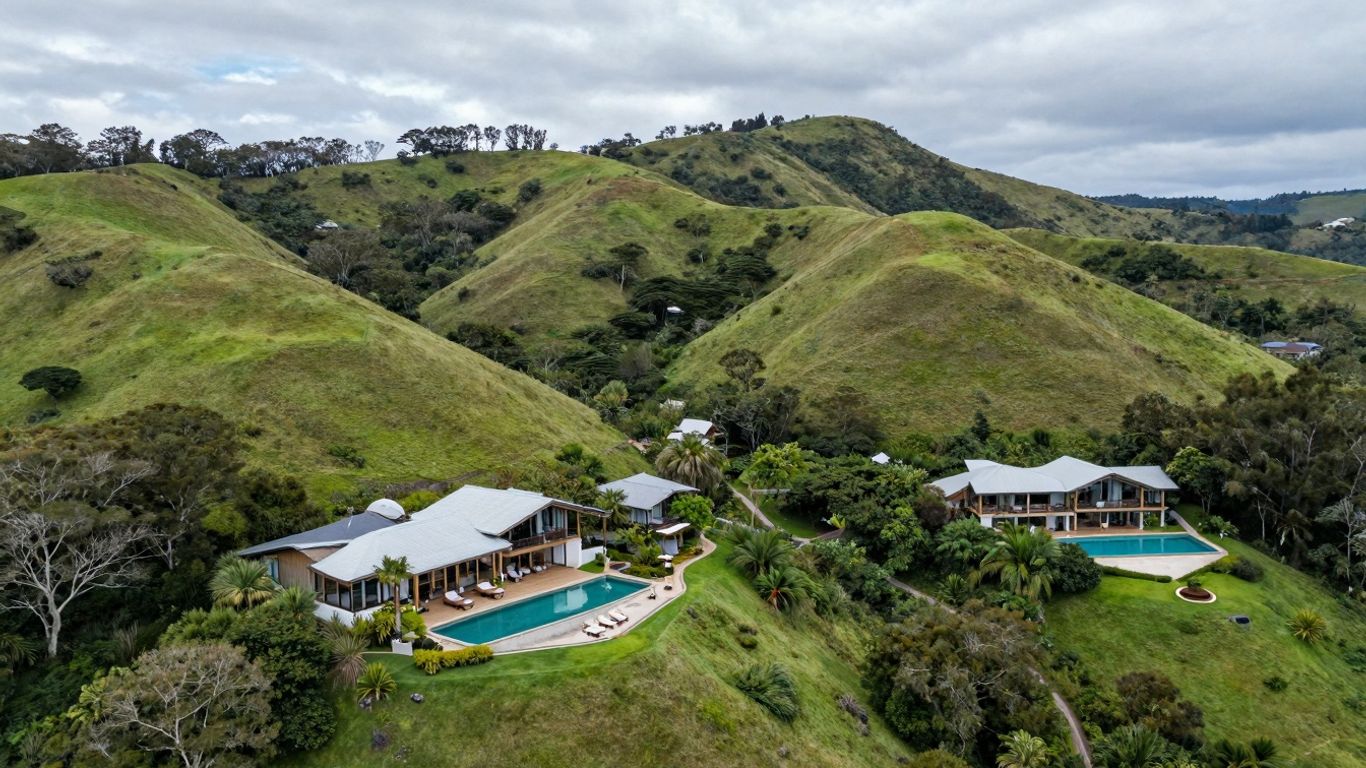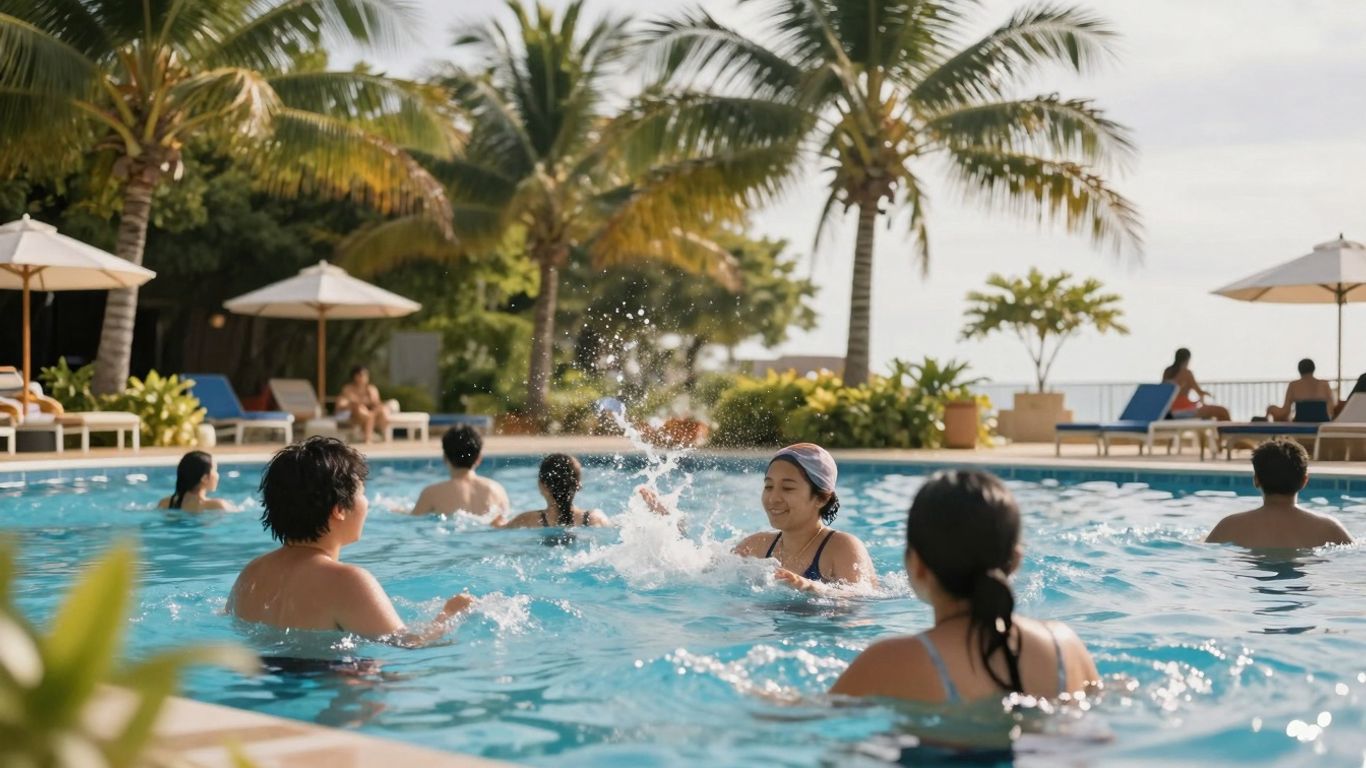Keeping your swimming pool sparkling and safe is simpler than it seems. With the right knowledge about swimming pool chemistry, you can easily achieve crystal clear water that’s inviting for everyone. This guide breaks down the essentials of pool maintenance, from understanding the chemistry behind it to tackling common issues, ensuring you enjoy your pool all season long.
Key Takeaways
- Maintain a balanced pH level between 7.4 and 7.6 for optimal water quality.
- Regularly test and adjust total alkalinity to stay between 100-150 ppm.
- Chlorine levels should be kept between 1.0 and 3.0 ppm to effectively sanitise your pool.
- Invest in a good filtration system and keep it clean to ensure clear water.
- Shocking your pool weekly helps eliminate contaminants and keeps the water fresh.
Understanding Swimming Pool Chemistry
The Importance of pH Levels
Okay, so you’ve got a pool. Great! But just chucking water in and hoping for the best isn’t going to cut it. You need to get your head around pool chemistry, and it all starts with pH. pH is basically a measure of how acidic or basic your pool water is. Think of it like the foundation of everything else. If your pH is out of whack, nothing else you do will really work properly. You’ll be throwing money down the drain with all those chemicals. Aim for a pH between 7.2 and 7.8. Too low, and the water becomes corrosive, eating away at your pool equipment and irritating swimmers’ eyes. Too high, and you’ll get scaling, cloudy water, and reduced chlorine effectiveness. Not ideal, right?
- Test your pool water regularly, at least twice a week, using a reliable test kit.
- Adjust the pH using pH increaser (sodium carbonate) or pH decreaser (sodium bisulfate), following the product instructions carefully.
- Always test again after making adjustments to ensure you’ve hit the sweet spot.
Keeping your pH balanced is the first step to a healthy and enjoyable swimming experience. It’s not rocket science, but it does require a bit of attention.
Total Alkalinity Explained
Think of total alkalinity pool alkalinity as the pH’s bodyguard. It’s a measure of the water’s ability to resist changes in pH. If your alkalinity is too low, your pH will swing wildly, making it difficult to keep balanced. Too high, and the pH will be stubborn and hard to adjust. The ideal range for total alkalinity is between 80 and 120 parts per million (ppm). Here’s a quick guide:
| Alkalinity Level (ppm) | Issue | Solution |
|---|---|---|
| Below 80 | pH instability, corrosion | Add alkalinity increaser (sodium bicarbonate) |
| Above 120 | pH lock, scaling, cloudy water | Add muriatic acid or dry acid |
To adjust alkalinity, use either sodium bicarbonate (baking soda) to increase it or muriatic acid to decrease it. Always add chemicals slowly and test the water after each adjustment. It’s a bit of a balancing act, but once you get the hang of it, it becomes second nature.
Calcium Hardness and Its Role
Calcium hardness refers to the amount of dissolved calcium in your pool water. It’s particularly important if you have a concrete or plaster pool, as it helps prevent the water from dissolving calcium from the pool surface. If the calcium hardness is too low, the water becomes aggressive and can etch or corrode the pool. Too high, and you’ll get scaling and cloudy water. Aim for a calcium hardness level between 200 and 400 ppm. Here’s what you need to know:
- Low calcium hardness can damage pool surfaces and equipment.
- High calcium hardness leads to scaling and cloudy water.
- Use calcium chloride to increase calcium hardness and a water softener to decrease it (though draining and refilling with fresh water is often the best solution for high levels).
Maintaining Water Balance
Alright, so you’ve got your pool, and you’re keen for a swim. But before you jump in, let’s talk about keeping that water balanced. It’s not just about chucking in some chlorine and hoping for the best. It’s about regular checks and tweaks to make sure everything’s spot on. Think of it like baking a cake – you need the right ingredients in the right amounts, or it’ll be a flop. Same goes for your pool water.
Regular Testing for Optimal Levels
Testing your pool water regularly is the cornerstone of maintaining a healthy and balanced swimming environment. I usually test mine at least twice a week during the swimming season, and maybe once a week during the cooler months. You can grab a test kit from pretty much any pool shop, or even some hardware stores. They’re not too expensive, and they’ll save you a heap of trouble in the long run. Digital testers are also available, but I find the good old-fashioned test strips do the job just fine.
Here’s what I usually look for:
- pH levels: Aim for between 7.2 and 7.8. Too high or too low, and you’ll end up with irritated skin and eyes.
- Total Alkalinity: Keep it between 80 and 120 ppm. This helps keep the pH stable.
- Chlorine: Between 1 and 3 ppm is ideal for sanitisation.
Adjusting pH and Alkalinity
So, you’ve tested your water, and something’s out of whack. Don’t stress! Adjusting pH and alkalinity is usually pretty straightforward. If your pH is too low, you can add a pH increaser (usually sodium carbonate). If it’s too high, use a pH reducer (sodium bisulfate). For alkalinity, you’ll want to use an alkalinity increaser, which is usually sodium bicarbonate. Just follow the instructions on the product label, and you’ll be right as rain. Remember to always add chemicals slowly and test the water again after a few hours to see if you’ve hit the sweet spot. It’s a bit of a balancing act, but you’ll get the hang of it. You can also look into pool maintenance for more tips.
Managing Chlorine Levels
Chlorine is your main weapon against bacteria and algae, so keeping those levels in check is super important. You can use chlorine tablets in a floating dispenser, or a salt water chlorinator. I prefer the tablets because they’re easy to use and relatively cheap. Just make sure you’re using the right amount for your pool size. If your chlorine levels are too low, you’ll end up with a green, slimy mess. Too high, and you’ll be coughing and spluttering every time you go for a dip. Aim for that 1-3 ppm range, and you’ll be golden. Also, remember that sunlight can break down chlorine, so you might need to add a stabiliser (cyanuric acid) to protect it.
Keeping your pool water balanced might seem like a chore, but it’s worth it in the long run. Not only will it keep your pool sparkling clean, but it’ll also protect your equipment and keep your swimmers happy and healthy. So, grab your test kit, get to know your chemicals, and enjoy that crystal-clear water!
The Role of Pool Filtration
Your pool philtre is the workhorse that keeps your water sparkling. It removes debris, dirt, and other unwanted particles, ensuring a clean and safe swimming environment. Without proper filtration, your pool water would quickly become cloudy and unhygienic. Let’s dive into the specifics of pool filtration.
Types of Pool Philtres
There are three main types of pool philtres, each with its own pros and cons:
- Sand Philtres: These are the most common and generally the cheapest option. They work by passing water through a bed of sand, which traps dirt and debris. They’re relatively low-maintenance but require regular backwashing to clean the sand.
- Cartridge Philtres: These philtres use a pleated cartridge to trap particles. They offer finer filtration than sand philtres and require less frequent backwashing. However, the cartridges need to be cleaned or replaced periodically.
- Diatomaceous Earth (DE) Philtres: DE philtres provide the best filtration, using a fine powder of fossilised algae to trap even the smallest particles. They require more maintenance than other types and the DE powder needs to be replenished after each backwashing.
Cleaning and Maintenance Tips
Regular cleaning and maintenance are crucial for keeping your pool philtre working efficiently. Here are some tips:
- Backwash Regularly: For sand and DE philtres, backwashing reverses the flow of water to flush out trapped debris. Do this when the pressure gauge reads 8-10 PSI above normal.
- Clean Cartridges: For cartridge philtres, remove the cartridge and hose it down thoroughly. You can also soak it in a philtre cleaner solution to remove stubborn dirt and oils.
- Inspect for Damage: Regularly check your philtre for cracks, leaks, or other damage. Replace any worn or damaged parts promptly.
- Maintain Proper Chemical Balance: Balanced pool chemicals help prevent scale buildup and other issues that can clog your philtre.
Maintaining your pool philtre isn’t just about keeping your pool looking nice; it’s about protecting your health and the health of your swimmers. A clean philtre removes harmful bacteria and other contaminants, ensuring a safe and enjoyable swimming experience.
Signs Your Philtre Needs Attention
Knowing when your philtre needs attention can save you from bigger problems down the road. Here are some signs to watch out for:
- Cloudy Water: This is often the first sign that your philtre isn’t working properly. A water clarifier can help clear cloudy pool water.
- High Pressure: A consistently high-pressure reading on the philtre gauge indicates that the philtre is clogged and needs backwashing or cleaning.
- Reduced Water Flow: If you notice that the water flow in your pool is weaker than usual, it could be due to a clogged philtre.
- Visible Debris: If you see debris floating in your pool despite regular cleaning, your philtre may not be trapping particles effectively.
Ignoring these signs can lead to bigger problems, like algae growth and increased chemical usage. So, keep an eye on your philtre and address any issues promptly. Remember to check the shock product instructions before using it.
Shocking Your Pool Effectively
Shocking your pool is like hitting the reset button. It’s a process where you add a high dose of chlorine (or a non-chlorine shock) to eliminate nasties like algae, bacteria, and combined chlorine (chloramines). Basically, it gives your pool a super-boost of sanitiser to get it back to sparkling. It’s not something you do every day, but it’s a crucial part of pool maintenance.
When to Shock Your Pool
Knowing when to shock your pool is just as important as knowing how. Here are a few key times:
- After heavy use: Big pool party? Shock it. Lots of swimmers introduce more contaminants.
- After rain: Rain can bring in all sorts of pollutants, throwing off your water balance.
- When algae is present: If you see green, shock is a must. Algae can take over quickly.
- Every week or two during peak season: Regular shocking helps prevent problems before they start.
- When combined chlorine levels are high: If your chlorine smells strong, it’s probably chloramines. Shocking breaks them down.
Choosing the Right Shock Treatment
There are a few different types of shock treatments available, and choosing the right one depends on your needs and preferences. Here’s a quick rundown:
- Calcium Hypochlorite (Cal Hypo): This is a common and powerful option. It raises chlorine levels quickly but can also increase calcium hardness. It can also cloud the water temporarily.
- Dichlor: This is another chlorine-based shock that dissolves quickly and doesn’t affect calcium levels as much as Cal Hypo. However, it can increase stabiliser (cyanuric acid) levels.
- Non-Chlorine Shock (Potassium Monopersulfate): This is a good option if you want to shock your pool without significantly raising chlorine levels. It’s often used to break down chloramines and can be used more frequently than chlorine-based shocks. You can swim sooner after using this type of shock.
It’s always a good idea to test your pool water before and after shocking to make sure you’re achieving the desired results. Keep an eye on your pH and alkalinity levels, as shocking can sometimes affect these.
Safety Precautions During Shocking
Safety first, always! Shocking involves handling chemicals, so it’s important to take precautions:
- Read the label: Always follow the manufacturer’s instructions on the shock product. They know best.
- Wear protective gear: Gloves and eye protection are a must. You don’t want to get chemicals on your skin or in your eyes.
- Add shock to water, not the other way around: Never add water to the shock. This can cause a dangerous reaction.
- Shock at dusk or night: Sunlight can degrade chlorine, so it’s best to shock when the sun isn’t shining. This gives the shock more time to work.
- Run your pump: Keep your pool pump running for at least 8 hours after shocking to circulate the chemicals properly. This ensures the pool philtre does its job.
Shocking your pool is a simple way to keep your pool water clean and healthy.
Dealing with Common Pool Issues

Addressing Cloudy Water
Cloudy water is a really common headache for pool owners. It’s often a sign that something’s not quite right with your water balance or filtration. First thing’s first, check your philtre. Give it a good backwash if it’s a sand or D.E. philtre. Cartridge philtres might just need a clean, or worse case, replacing.
Here’s a quick checklist:
- Check your philtre pressure – is it higher than usual?
- Test your water chemistry – pH, alkalinity, and calcium hardness.
- Consider using a water clarifier to help clump those tiny particles together.
If your chemicals are out of whack, adjust them accordingly. Sometimes, a good shock treatment can also do the trick. If you’ve had heavy rain or a lot of swimmers, that can throw things off too.
Preventing Algae Growth
Nobody wants a green pool! Algae can be a real pain, but with a bit of prevention, you can keep it at bay.
- Regularly test and balance your water. Keep that chlorine level in check!
- Use an algaecide weekly, especially during the warmer months. Think of it as your pool’s bodyguard.
- Brush the pool walls and floor regularly to disrupt algae before it gets a foothold.
- Make sure your filtration system is running properly and for enough hours each day.
Algae loves sunlight and stagnant water. Keep your pool circulating and sanitised, and you’ll be winning the battle against the green stuff. Prevention is always better than cure!
Managing Contaminants
Besides the usual chemical balance, you’ve also got to think about all the other stuff that ends up in your pool – leaves, sunscreen, oils, you name it.
- Skim the surface regularly to remove leaves and debris. A good pool skimmer is your best mate here.
- Consider using enzymes. They’re like tiny Pac-Men that break down oils and other organic gunk.
- Shock your pool periodically, especially after heavy use or a rainstorm. This helps to oxidise and get rid of contaminants.
- Keep an eye out for stains or scale build-up. Use a stain and scale remover if needed. Prevention is key, so keep those chemical levels balanced!
Seasonal Swimming Pool Care
Preparing Your Pool for Summer
Right, summer’s almost here, and that means it’s time to get the pool ready for action! First things first, remove the pool cover and give it a good clean. You don’t want all that winter grime ending up in your sparkling water. Then, it’s time to fill ‘er up, check all the equipment, and get the chemicals balanced. Nobody wants a green swamp instead of a pool, eh?
- Remove and clean the pool cover.
- Fill the pool to the correct level.
- Inspect the pump, philtre, and heater for any damage.
Getting your pool ready for summer is more than just a quick scrub. It’s about ensuring everything is in tip-top shape for months of fun. Don’t rush the process; take your time and do it right.
Winterising Your Pool
Okay, so summer’s over, and it’s time to say goodbye to swimming for a while. Winterising your pool properly is super important to prevent damage from the cold. You’ll need to drain some of the water, add winterising chemicals, and cover the pool securely. Trust me, future you will thank you when you open it up next summer and it’s not a disaster zone. Make sure you get a pool skimmer to keep the pool clean.
- Lower the water level.
- Add winterising chemicals to prevent algae and scaling.
- Cover the pool with a durable winter cover.
Off-Season Maintenance Tips
Just because you’re not swimming doesn’t mean you can forget about the pool entirely. A little bit of off-season maintenance can save you a lot of hassle later on. Check the cover regularly, make sure water isn’t pooling on top, and give the equipment a once-over every now and then. It’s all about preventing problems before they start. Keep an eye on the chlorine pucks and chemical levels.
- Regularly check the pool cover for damage or pooling water.
- Inspect equipment for signs of wear and tear.
- Occasionally test the water chemistry, even during the off-season.
Investing in Pool Equipment

Alright, let’s yarn about chucking some dosh at decent pool gear. It’s not just about having a pool; it’s about making sure it’s actually enjoyable to use and doesn’t turn into a massive headache. Getting the right equipment can save you time, money, and a whole lot of stress in the long run. Think of it as an investment in your sanity, really.
Choosing the Right Pump
The pool pump is the heart of your entire pool system. It keeps the water circulating, which is super important for distributing chemicals evenly and keeping the water clean. You don’t want stagnant water breeding mozzies, do ya? When you’re picking a pump, think about the size of your pool and how much water it holds. A bigger pool needs a more powerful pump. Also, look into variable-speed pumps. They might cost a bit more upfront, but they’re way more energy-efficient, which means lower power bills. Plus, they’re quieter – bonus!
Benefits of a Pool Timer
Pool timers are absolute lifesavers. Instead of having to manually switch your pump on and off every day, you can set a timer to do it for you. This is great for a few reasons:
- Saves energy: You can set the pump to run only during off-peak hours, which can save you a fair bit on your electricity bill.
- Consistent water circulation: Regular circulation helps keep the water clean and prevents algae from growing.
- Convenience: You don’t have to remember to turn the pump on and off. Set it and forget it!
Honestly, a pool timer is one of those things you don’t realise you need until you have one. It just makes life so much easier. It’s like having a little robot that takes care of your pool for you.
Essential Tools for Pool Maintenance
Okay, so you’ve got the big stuff sorted. Now, let’s talk about the smaller, but still important, tools you’ll need to keep your pool sparkling. Here’s a quick rundown:
- Telescopic pole: For attaching all sorts of cleaning attachments.
- Leaf skimmer: To scoop out leaves, bugs, and other debris from the surface.
- Pool brush: For scrubbing the walls and floor of the pool to prevent algae buildup.
- Water testing kit: Absolutely crucial for keeping your pool chemicals balanced. Get a good one that tests for pH, chlorine, alkalinity, and calcium hardness.
Having these tools on hand will make your pool maintenance routine a breeze. Trust me, a little bit of regular upkeep is way better than dealing with a swampy mess later on.
Wrapping It Up
Keeping your pool water clear and inviting doesn’t have to be a chore. With a bit of routine and the right knowledge, you can make it happen. Regularly check your water chemistry, keep an eye on those pH levels, and don’t forget to shock your pool when needed. It’s all about balance. If you stay on top of your cleaning and maintenance, you’ll have a sparkling pool ready for fun all summer long. So grab your gear, get into a routine, and enjoy your time in the water!
Frequently Asked Questions
What is the ideal pH level for my pool?
The best pH level for pool water is between 7.4 and 7.6. This keeps the water safe and comfortable for swimming.
How often should I test my pool water?
You should check your pool water at least once a week to ensure the chemical levels are just right.
What should I do if my pool water is cloudy?
If your pool water is cloudy, it might be due to imbalanced chemicals or dirt. You can use a water clarifier to help clear it up.
How can I prevent algae from growing in my pool?
To stop algae from growing, use an algaecide weekly and keep your chlorine levels balanced.
What is the purpose of shocking my pool?
Shocking your pool means adding a lot of chlorine to kill germs and clear up the water. It’s best to do this after heavy use or rain.
How do I maintain my pool philtre?
You should clean your pool philtre every 4-8 weeks. This keeps it working well and helps keep your pool water clear.





